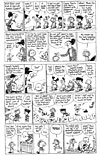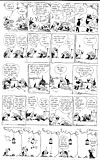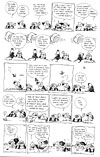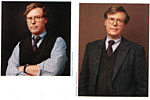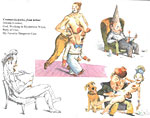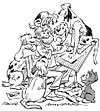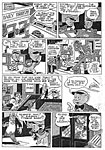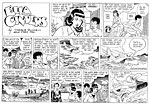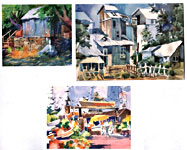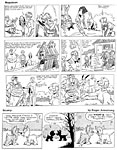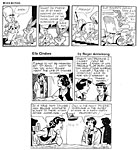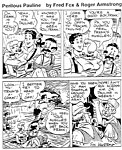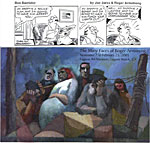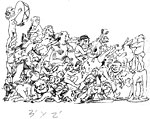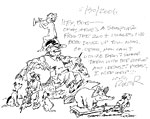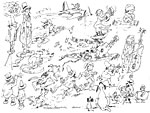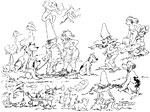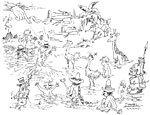 |
|||||||||||||
|
Opus 207 (June 30, 2007). We spend a long time fondly
remembering Roger Armstrong, a
superb watercolorist and a life-long cartoonist. Otherwise, our big news is
about David Kunzle’s two new books on Rudolphe
Topffer, both excellent; we do a review. Ditto of John Cuneo’s nEuROTIC, a
delicious assault on conventionality. And more. Here’s what’s here, by
department:
NOUS R US
Eisner’s
The Plot Declined at European Parliament
NPR
Picks Graphic Novels for Summer Reading
Homer
Simpson Stolen and Returned
Gordon
Lee Trial Starts August 13
COMIC STRIP WATCH
Lisa
Moore’s Fate
Some
Edgy Moments
Mutt
and Jeff Gay? The Answer, Sort Of
New
’Tooner Debuts on B.C.
Two
New Strips: Cul de Sac and Little Dog Lost
Civilization’s
Last Outpost
Hip-hop
Dying?
Don
Imus Some More
EDITOONERY
AAEC
Celebrates Its Fiftieth July 5-7
Editoons
Reflect Worldwide Opinion of U.S.
Onward,
the Spreading Punditry
Cullen
Murphy and The Purchase of Government and the Outsourcing of Same
BOOK MARQUEES
David
Kunzle is Back With Topffer, Two of Them
John
Coneo’s Scandalous Tome
ROGER ARMSTRONG
1917-2007
Son
of the Spreading Pundtry
Oswald
Acted Alone, Now Leave Me Alone
Ethanol
Won’t Help and It Will Hurt
And
our customary reminder: don’t forget to activate the “Bathroom Button” by
clicking on the “print friendly version” so you can print off a copy of just
this lengthy installment for reading later, at your leisure while enthroned.
Without further adieu—
NOUS R US
All the News That Gives Us Fits
This
summer is fraught with anniversaries. As we mentioned last time, “Sgt. Pepper’s
Lonely Hearts Club Band” album debuted 40 years ago, the same year that spawned
the “Summer of Love” in San Francisco; more about which, next time or two.
Charles Lindbergh flew solo across the Atlantic 80 years ago, and 50 years ago,
Jack Kerouac’s rambling novel, On the
Road, came out. Kerouac typed the book on 12-foot-long strips of paper,
which he then taped together to make a continuous scroll. After three weeks of
perpetual typing, he had 120 feet of typescript, which, with several revisions,
was published by Viking Press. Kerouac’s method seemed so absolutely logical,
so linearly wedded to its purpose, that I adopted it for producing term papers
during my so-called college career: using rolls of teletype paper, I typed
quotations from source books until I turned out 12 feet of scroll, then pulled
it out of the typewriter, cut the scroll up into individual quoted passages,
pasted them together in some sort of narrative sequence, and re-typed it all
with connecting prose between quotations. A 12-foot scroll usually yielded a
15-page paper, just the prescribed length. That summer in 1957, a piano-player
friend of mine named Lee Underwood devoured Kerouac’s book at a single sitting,
reading all night long, and the next day, he packed a suitcase and hit the
road. We never saw him again.
In Brussels, the European Parliament
has refused to distribute to its members copies of Will Eisner’s The Plot: The
Secret Story of the Protocols of the Elders of Zion, which had been
supplied in quantity by the Transatlantic Institute, a Brussels-based
think-tank attempting to foster ties among the European Union, Israel and the
United States. But the decision was not an anti-Semitic inspiration. As
reported by Yossi Lempkowicz of the European Jewish Press, since the book has
no direct relevance to the Parliament’s legislative agenda, distributing it
seemed to officials to promote sales of the graphic novel, and the body’s
policy prohibits advertising and all such commercial enterprise. An explanatory
letter added that the decision was “independent of the positive opinion each of
us may have regarding the cause defended by the book.” While the European
Parliament may not have anti-Semitism on its agenda, the Middle East does: Arab
schools harbor anti-Semitic curriculum, and the nefarious book at issue, The Protocols of the Elders of Zion, “the lie that will not die,” enjoys brisk sales throughout the region. A French
version of the book in novel form was sold in the European Parliament’s
bookshops until late May when the President of the Parliament ordered their
removal. Seems right, albeit somewhat belated. As Emmanuele Ottolenghi,
executive director of the Transatlantic Institute, said, “Why should the Protocols be easily available in the
Parliament but the refutation of the Protocols [Eisner’s book] would not be allowed to reach the members?”
BookExpo America is one of the
“largest industry conventions on the circuit,” we are told at
bookshelf.diamondcomics.com, the website of the nation’s largest distributor of
comics and graphic novels and their ilk. Not surprisingly, considering the
source, BookExpo America 2007 was “a rousing success” with over 2,000 exhibits,
500 authors and 60 conference sessions, at least two of which were devoted to
graphic novel and comics-related topics. One of them, titled “Taking Kids’
comics to the Next Level,” asked what the challenges are “facing graphic novels
in the children’s section of the bookstores?” In the children’s section? This
sort of success doesn’t seem all that rousing to me. “Rousing” would be when
the book trade starts seeing graphic novels as literature for grown-ups.
At the same website, we learn that
National Public Radio (NPR) has listed a number of graphic novels on its Summer
Books 2007 series—namely, David Peterson’s Mouse
Guard Volume 1: Fall 1152, Kieron Gillen and Jamie Mckelvie’s Phonogram: Rue Britannia, Bryan Lee
O’Malley’s Scott Pilgrim Volume 1: Scott
Pilgrim’s Precious Little Life, and Cecil Castellucci and Jim Rugg’s The Plain Janes. ... At Woodstock,
Illinois, during this year’s annual five-day festival, Dick Tracy Days (June 20-24), Jean Gould O’Connell, the daughter of
Tracy’s creator, signed copies of her new book, Chester Gould: A Daughter’s Biography of the Creator of Dick Tracy. Said O’Connell, quoted in the Northwest
Herald by Jenn Wiant: “I think the book really tells a great story about a
man who came from a very poor family in Oklahoma and raised himself up by the
bootstraps. He had determination as a young boy to become a cartoonist, even at
the age of seven, and he fulfilled that dream.”
In Kuala Lumpur, Malaysia, the Homer
Simpson thieves have been apprehended and Homer restored to his place in a
display at a local cinema, where he was promoting the impending Simpsons movie.
Two college students made off with a life-sized fiberglass Homer replica in the
wee hours of June 18, according to Sean Yoong of the Associated Press at
news.yahoo.com, but they reckoned without the vigilant close-circuit security
cameras, which showed the thieves stowing the four-foot Homer in the trunk of
their car and speeding away, the car license plate in full view, and the police
tracked them down. Homer was returned unscathed. “The Simpsons Movie” opens in
Malaysia on June 26, the day before its U.S. release.
Mutts creator Patrick McDonnell spoke
at the first graduation ceremony at James Sturm’s Center for Cartoon Studies.
Among his remarks were these: “When I started my comic strip Mutts, it was just an idea about my own
dog Earl, and a silly cat named Mooch. Seeing the world through the eyes of
animals made me more aware and empathetic to their lives. I began to realize
how tough it is for all animals on this small planet, and how fragile and
sacred all life is. This became a big part of Mutts and led to my becoming a director on the board of the Humane
Society of the United States. Saying that Mutts changed my life is an understatement.”
From Charles Brownstein, Executive
Director of the Comic Book Legal Defense Fund: “We hope to bring the Gordon Lee
case to a close when Lee [owner of a comic book store in George] goes to court
[August 13] to face down the two remaining misdemeanor charges of ‘Distribution
of Harmful to Minors Materials’ left in the case. Since taking the case last
year, the Fund has knocked out both felony counts of ‘dissemination of
Unsolicited Nudity/Sexual Conduct’ and three of the five misdemeanor counts.
... The charges Lee faces arise from accidentally distributing Alternative Comics No. 2, a Free Comic
Book Day anthology including an excerpt from Nick Bertozzi’s ‘The Salon’ [that
depicted] the first meeting of Georges Braque and Pablo Picasso. On three pages
of the eight-page section, Picasso is depicted in the nude, a factually
accurate detail for the period during which the story is set. [That is, Picasso
usually went around his studio naked.] There is no sexual content in the story.
The comic was inadvertently distributed to a minor during a 3-hour Hallowe’en
promotion where 2,200 comics were given away [at Lee’s Legends comic book store
in Rome, Georgia]. Lee offered apology but it was refused, and within days, he
was arrested and fighting for his survival.” If you think this case is absurd
in the extreme, remember who elected GeeDubya twice. To contribute to the cause
and/or to join the CBLDF, visit www.cbldf.org
Mandrake, the comic strip magician
who uses powers of illusion and hypnotism to fight crime, may get into the
movie theaters in the future. The strip created by Lee Falk in 1934 has attracted the attention of
magician/illusionist Criss Angel, star of the “Mindfreak” tv show on A&E;
the movie’s director is reported by Editor
& Publisher to be Chuck Russell, who directed “The Mask,” another
comic-related creation. ... The Superman costume worn by Christopher Reeve in the initial Superman movie sold for
$16,750 at a London auction June 20 (news.yahoo.com). ... The latest plastic
action figure on Hasbro’s production schedule is Stan Lee, who will be cast six inches tall in khaki pants, blue
windbreaker, and shades. The
Fascinating
Footnote. Much of the news
retailed in this segment is culled from articles eventually indexed at http://www.rpi.edu/~bulloj/comxbib.html, the Comics Research Bibliography, maintained by Michael Rhode and John
Bullough, which covers comic books, comic strips, animation, caricature,
cartoons, bandes dessinees and
related topics. It also provides links to numerous other sites that delve
deeply into cartooning topics. Three other sites laden with cartooning news and
lore are Mark Evanier’s www.povonline.com, Alan Gardner’s www.DailyCartoonist.com, and Tom Spurgeon’s www.comicsreporter.com.
And then there’s Mike Rhode’s ComicsDC blog, http://www.comicsdc.blogspot.com
COMIC STRIP WATCH
In Brooke McEldowney’s 9 Chickweed Lane, Thorax, the
other-worldly (that is, alien) gentleman farmer, shows up occasionally with his
“Locutionary Field Guide to Earth,” usually defining an ordinary term in ways
we would not, normally, anticipate. For instance: “Patriotism, noun: The
willing act of putting one’s well-being at risk for politicians who are not
similarly disposed.” McEldowney’s superb strip, regrettably not widely
circulated, is one of the strips that will be spotlighted in Alan Gardner’s News Free Comics, a publication
presently on hiatus pending the recruitment by August of at least 2,000
subscribers. Other modestly circulated comic strips on Gardner’s list include Michael Jantze’s The Norm (currently available online by subscription at www.thenorm.com), Jef Mallett’s Frazz, and some other favorites. Visit Gardner’s website, just
cited above.
Culled from Editor & Publisher: Lisa Moore, the character with recurring
breast cancer in Tom Batiuk’s Funky Winkerbean strip, will die this
year according to a report in the Cleveland
Free Press. Also this year, the cast of the strip will grow older by ten
years. Batiuk aged them all in the early 1990s, transforming his high school
teenagers into young adults. ... Scott
Adams posted his Dilbert submission package on his website—the strips that sold the feature into
syndication, plus an assortment of mixed reactions to the strip. “One syndicate
suggested that Adams collaborate with a more accomplished artist.” ... Legacies
continue to expire. The Commercial
Dispatch of Columbus, Mississippi, added seven strips to its comics line-up
by dropping seven others, including four legacy strips: B.C., The Wizard of Id, Blondie, and Dennis the Menace.
In our continuing survey of current
comic strips to discover just how many taboos are being discarded these days,
we see that Wally, one of Dilbert’s co-workers, has been identified as “a
source of methane,” which Dogbert “the Green Consultant” decides to capture “as
a free source of energy that we can use to power a small office building.” In
the final panel, Wally is depicted with a tube attached to his rear end. What a
gas! But fart jokes were verboten in the funnies for eons. ... And here’s Shoe for June 22, in which Roz, the
diner owner, tells the Perfessor that she’s not going to sponsor the bowling
team this year, an announcement met with a mild protest—“C’mon, Roz: it’ll give
you a nice warm feeling to help us out”—to which Roz responds: “The last thing
a gal my age needs is more warm feelings.” Menopause comedy. ... Jeff, I guess,
lives with the Mutt family. I wondered, some weeks ago, what the living
arrangements were for Bud Fisher’s famed Mutt and Jeff. The two are often
depicted in a domestic setting, suggesting that they share an apartment. But
Mutt is married, and sometimes the gags feature his wife or son. Still, the
mystery remained: I said that Mrs. Mutt and Johnny
Hart’s B.C. has completed the
month-long commemorative re-running of the Hart family’s favorite strips and,
on June 11, began the new crop, drawn by Hart’s grandson, Mason Mastroianni. According to Perri, Hart’s youngest daughter:
“Mason is an accomplished artist ... [who] picked up his Cul
de Sac is a new comic strip from Universal Press produced by Richard Thompson, a humorous
illustrator who achieved more than fifteen minutes of fame on the Web in 2002
with a poem composed of actual quotes from GeeDubya. Entitled “Make the Pie
Higher,” this is the poem:
I
think we all agree, the past is over.
This
is still a dangerous world.
It’s
a world of madmen and uncertainty
And
potential mental losses.
Rarely
is the question asked
Is
our children learning?
Will
the highways of the Internet become more few?
How
many hands have I shaked?
They
misunderestimate me.
I
am a pitbull on the pantleg of opportunity.
I
know that the human being and the fish can co-exist.
Families
is where our nation finds hope, where our wings take dream.
Put
food on your family!
Knock
down the tollbooth!
Vulcanize
society!
Make
the pie higher! Make the pie higher!
Cul de Sac, on the other hand, is reality-based, the reality
being the world of a four-year-old named Alice Otterloop, who lives, naturally,
on a cul de sac. There, New last March from Washington Post Writers Group is Little Dog Lost, a talking animal strip by Steve Boreman, who deploys his animals in that fashion honored by satirists ever since Aesop—namely, to comment upon the human condition. The eponymous canine wanders the world and encounters all sorts of personalities on his way—scavengers like the Vulture and Jackson the Crow, Vernon the grumpy tortoise, always complaining; Beavers who are real estate developers, and Carlton the mouse (who the Vulture won’t eat because he’s on a first-name basis with the rodent). Said comics editor Amy Lago: “What I love about Little Dog Lost is its layers. Steve gives you a shoal-draft level of humor that will amuse any reader. The more thoughtful ones will also see its deeper meaning—its commentary on nature, human nature, and humans’ effect on the earth—and pat themselves on the back for getting it. It’s a perfect way to please the readers.” Boreman, who has freelanced as an illustrator and taught design and digital illustration at the Columbus (Ohio) College of Art and Design for twelve years, draws in a loose-limbed but lumpy manner, pleasing to the eye through the variety of his compositions and treatments. Here are some samples.
Read
and Relish
“There are two kinds of people in
the world: those who divide the world into two kinds of people and those who
don’t.” —Robert Benchley
And if you want to read why Esquire’s cover story on Angelina Jolie
is “the worst celebrity profile ever written,” go to http://www.Slate.com/toolbar.aspx?action=print&id+2168707 where you’ll find Ron Rosenbaum’s June 19 essay with the title just quoted.
It’s a hoot.
CIVILIZATION’S LAST OUTPOST
One of a kind beats everything. —Dennis
Miller adv.
USA Today reported (June 15-17) that hip-hop “with declining sales and concerns about its quality and
‘gangsta’ image, is in crisis. Even some rappers say it risks becoming
irrelevant.” Sales of rap albums are down 33% from last year, “twice the
decline for the [record] industry overall.” The paper reviews the history of
the genre: “Hip-hop was born out of DJK-hosted block parties in the Bronx,
N.Y., in the early 1970s and evolved with emcees ‘rapping’ over the beats the
DJs played. The genre hit the Top 40 with the Sugar Hill Gang’s Rapper’s Delight in 1979. Rap soon
became, as Public Enemy’s Chuck D described it, ‘the CNN of black culture,’
encompassing everything from party tales to political commentaries, especially
from the view of poor and disaffected urban youths. Rap found an audience not
only in cities but in mostly white suburbs as well. By the 1990s, a
harder-edged version of rap that glorified gang life began to dominate music
and influence youth culture. Its songs and videos typically depict violence and
drug dealers awash in diamonds and platinum jewelry, champagne and scantily
clad women. Rap became a multibillion-dollar-a-year global industry,
influencing fashion, lifestyles and language while selling everything from SUVs
to personal computers.”
When Don Imus attracted attention in April for his racist remarks, the
resulting fall-out rained a little on hip-hop, which made popular the kind of
language that inspired Imus and his cohorts. Commentators on the Imus imbroglio
also sometimes called for a clean-up in hip-hop lingo. Oddly, now that we’re
far enough away from the Imus incident to view it somewhat dispassionately—at
least, perhaps, without heat—it seems likely that he was attempting, in his
clumsy good old boy manner, to praise the Rutgers’ women’s basketball team.
Tennesse beat Rutgers, and Imus marveled at the achievement because the Rutgers
team had a reputation for being very good and very tough. “That’s some rough
girls from Rutgers,” he said, in seeming admiration, “—man, they got tattoos
and—.” “Some hard-core hos,” chimed in Bernard McGuirk, Imus’s on-air buddy and
duty goad. Then Imus piled on McGuirk’s remark: “That’s some nappy-headed hos there. I’m gonna tell
you that now, man, that’s some—woo! And the girls from Tennessee, they all look
cute, you know, so, like—kinda like—I don’t know.” He was still being racist,
but he was also, in some perverse way, saying the Rutgers team was so tough
that it was difficult to imagine any other team could beat them. Well, that’s
the trouble with communication: it creates the illusion that it has been
accomplished.
EDITOONERY
Afflicting the Comfortable and
Comforting the Afflicted
From Editor & Publisher: The Denver Post’s editoonist Mike Keefe received the Freedom of the
Press award from the Anti-Defamation League’s Mountain States Office for his
cartoons about bigotry, separation of church and state and other similar
topics. ... Jim Morin of the Miami Herald is this year’s winner of
the $10,000 Herblock Prize for editorial cartooning. “He just gets better and
better,” said Jeff Danziger, who
collected the Prize last year and was therefore one of this year’s judges.
Morin won the Pulitzer in 1996.
The Association of American
Editorial Cartoonists celebrates its 50th anniversary during its
annual meeting, this year in Washington, D.C., July 4-7. Scheduled speakers
include Flemming Rose (he of the Danish Dozen fame), former White House
correspondent Helen Thomas, political columnist Mark Shields, Dana Priest, one
of the Washington Post reporters who
broke the Walter Reed Hospital story, “Daily Show” writer Kevin Bleyer, and
Democrat presidential candidate Dennis Kucinich, among others. We’ll report
first-hand the ensuing doings here in our next installment.
HOW EDITORIAL CARTOONS REFLECT PUBLIC
OPINION WORLDWIDE
And
How Foreign Cartoonists Look at the U.S.
Political cartoonist Daryl Cagle, who operates a website (www.cagle.msnbc.com) featuring a huge daily dose of political
cartoons, also runs a syndicate that markets many of the cartoons to other
websites and to print media. And he has a blog at his website, too, where he
occasional holds forth. On February 4, 2007, he wrote about how editorial
cartoons are accurate reflections of public opinion at the time they are drawn.
Because his syndicate distributes the work of several cartoonists from other
countries, Cagle regularly sees how the U.S. is perceived in other lands. His
is a unique insight, an uncommonly valuable insight. Here he is:
As a political cartoonist, I’d like
to think my cartoons influence public opinion, but that rarely happens. People
love a cartoon that they already agree with and hate cartoons that they already
disagree with. Editors like to choose editorial cartoons that they know their
readers will like, so cartoons end up being a reflection of public opinion. In
fact, political cartoons offer a great historical tool, giving a true picture
of the opinions and emotions of a society at any given time.
Historians seem to have discovered
political cartoons only recently, and I’ve started seeing a steady stream of
scholarly papers about my profession as college professors and students
suddenly look to my work and the work of my colleagues to support their
political positions. One widely held canard seems to be popular among the academics:
that the world supported the USA after 9/11 and this support was then
squandered by the Bush Administration's adventures in the Middle East.
Academics like to look at the
cartoons drawn immediately after the 9/11 attack, when, around the world, almost
every editorial cartoonist drew the same image of a weeping Statue of Liberty.
I drew one, too. In fact, most cartoonists are ashamed of their weeping
statues; we wish we could have a “do-over” where we wouldn’t draw the first
image to come to mind. Newspaper columnists all wrote much the same column
right after 9/11, but it is easier to notice matching cartoons than matching
columns, so cartoonists get the bad rap for “group-think.” Even so, our
matching cartoons were what the public wanted to see at that time, and I
probably received more mail from readers who loved my weeping Liberty than any
other cartoon I’ve drawn.
International political cartoonists
revile the USA in a uniform drumbeat of daily digs at America. The academics
don't notice that international political cartoons before 9/11 were almost as
negative about America as the cartoons now. After our matching, weeping
statues, the American and international cartoonists diverged. On 9/12 American
cartoonists started drawing patriotic cartoons portraying resolve, strength,
and the virtues of the New York Fire and Police Departments, standing tall as
twin towers. American cartoonists drew scores of images of a strong Uncle Sam,
threatening eagles, and a newly militant Statue of Liberty, demanding revenge.
Just after 9/11, the international
cartoonists depicted the irony of mighty America put in its place. A favorite,
foreign symbol for America is Superman, and we saw scores of images showing
both Superman and Uncle Sam defeated, injured, bleeding, and grieving. The
worldwide cartoonists treated 9/11 in the way that tabloids treat fallen
celebrities: with delight in the spectacle of a beautiful actress whois
overweight, or getting a messy divorce—or better yet, caught in a drunken
scene, screaming racial epithets so that we can see that the rich, powerful,
famous, conceited, fallen star was a hypocrite all along.
Some international cartoonists wrote
to me about the patriotic cartoons; they couldn’t believe American cartoonists
would choose to draw such cartoons by their own free will; we must have been
directed to draw that nonsense by the Bush Administration. Academics have
picked up on the idea of “self-censorship”; that cartoonists somehow didn’t
draw what they wanted to draw because the country wasn’t ready for jokes, or
editors didn’t want to see criticism of the Bush Administration at a time when
we all had to pull together.
In fact, the system worked as it
always had: some cartoonists criticized the government right away, some
cartoonists were joking immediately, most cartoonists held the same opinions as
their readers, editors selected cartoons they agreed with and thought their
readers would agree with. Newspapers ended up printing cartoons that accurately
reflected public opinion, both here and abroad. I have a few words for the
professors and college students:
(1) Editorial cartoons show that the
rest of the world didn’t like America before 9/11; they didn’t like us just
after 9/11; and they still don’t like us.
(2) The government doesn’t control
or intimidate American cartoonists or editors, now or then. Yes, we really
believe what we say in our cartoons. No, cartoonists are not hampered by
self-censorship.
(3) Please don’t ask me to comment
on your paper, thesis or dissertation about editorial cartoons. Just read this
column, then write about something else.
Onward, the Spreading Punditry
The Great Ebb and Flo of Things
Cullen
Murphy has about him a certain mussed and tweedy look, the look of a scholar of
medieval history, which is what he studied to get a master’s degree before
pursuing a career as a journalist. Some of us recognize Murphy as the former
managing editor of The Atlantic Monthly,
which he left last year after 22 years, and many of us recall him as the writer
of Prince Valiant, which duty he
performed for his father, the late John
Cullen Murphy, who succeeded the strip's originator, Harold Foster, when the latter retired in 1971. After departing the environs of The Atlantic Monthly, Cullen Murphy
joined the merry band at Vanity Fair as
an editor-at-large, and he has been pictured in two successive issues of the
magazine, April and May, as a contributor. In
May, Vanity Fair went green—with a
vengeance. Nearly every major article is about the rape of the environment or
the Bush League's connivance with the rapists. As editor-at-large, Murphy
picked many of the topics. In one of the shorter pieces, Robert F. Kennedy Jr.
provides brief reviews of the careers of many of GeeDubya's appointees to key
positions in government agencies charged with enforcing environmental laws; all
of these factotums worked, at one time or another in their professional lives,
for the polluting industries that they were now supposed to regulate. More than
100 of these appointees have worked
diligently in the backrooms of government to roll back decades of progress,
promoting and implementing "more than 400 measures that eviscerate 30
years of environmental policy." One such operative, Phillip Cooney, spent
four years "combing scientific documents issued by various federal
agencies in order to remove damaging statements about the oil industry and the
coal industry. He suppressed or altered several major studies on global warming
in order to protect the interests of his former clients." He had been the
chief lobbyist for the American Petrolelum Institute; he left the White House
in 2005 to go to work for Exxon Mobil. These Bushy legions, Kennedy says,
"have entered government service not to serve the public interest but
rather to subvert the very laws they are charged with enforcing." He ends
by quoting Jim Hightower: "Corporations don't have to lobby the government
any more. They are the government." In one of the longer pieces, William
Langewiesche rehearses the history of
Texaco and Chevron in steeping huge tracts of Ecuadorean Amazon landscape in
the toxic waste of their oil extraction operations over more than twenty years.
The hero of the piece is Pablo Fajardo, an Ecuadorean peasant cum lawyer who
leads the legal battle against Chevron. Said Fajardo: "One of the problems
with modern society is that it places more importance on things that have a
price than on things that have a value. Breathing clean air, for instance, or
having clean water in the rivers or having legal rights—these are things that
don't have a price but have a huge value. Oil does have a price, but its value
is much less. And sometimes we make the mistake."
In Vanity Fair’s April issue, Cullen Murphy contributes an out-take
from his forthcoming book, Are We Rome?
The Fall of an Empire and the Fate of America. Like many of the fashionable
doom-sayers, Murphy finds a fateful kinship between ancient Rome on the cusp of
its collapse and the United States, poised, now, on the brink of the 21st Century. I’ve already pontificated on the subject, claiming a greater kinship
between the U.S. and ancient India, which devolved as a civilization when it
became so populous that it couldn’t take care of its citizens. In his book, the
link Murphy finds between the U.S. and Rome is not in moral decay, the usual
symptom, but in privatizing—or “outsourcing,” to use the prevalent
term—government services. This phenomenon was rooted, Murphy claims, in the
evolution of Roman government, the purpose of which, ultimately, was to foster
the wealth and personal advancement of its operatives. I’ve often thought, in
recent years, that the whole function of the U.S. Congress is as a mechanism by
which its members decide how to divide up the tax revenue that is collected
every year. “Governance” is not at all on the agenda; neither is the well being
of the country. Congress, as far as the interests of its members are concerned,
has nothing to do with either. In Rome, government was accomplished by paying
private contractors for public services.
“The effect,” Murphy says, “is to
insert an independent agent, with its own interests to consider and protect,
into the space between public will and public outcome—a dynamic that represents
a potential ‘diverting of governmental force’ far more systemic and insidious
than outright venality.’” This sort of perversion has been moving rapidly into
the American government since the mid-1970s, when “government agencies [began]
farming out various functions to high-priced consultants, secretive think
tanks, and corporate vested interests—accountable to no one!” One of the industries that has enjoyed a
considerable growth surge in this vein is the private security business. In
1960, there were more police officers than private security guards; “today
private guards outnumber the police by a margin of 50 percent,” Murphy says.
“Individuals may owe nominal allegiance to a town or a state, but their true
oath of fealty is to Securitas or Guardsmark.”
Last year in the wake of the aborted
plan to turn over operation of half-a-dozen U.S. ports to DP World, a company
in the United Arab Emirates, we learned, and were shocked to discover, “that
the privatization of terminal operations at American ports had begun three
decades ago, and that 80 percent of them were already operated by foreign
companies, the largest of which is Chinese.”
Our misadventure in Iraq has
revealed just how much of the presumed function of government has been
contracted out to private concerns. Darth Cheney’s Halliburton and its
subsidiaries are doing much of the work for the military that, in the olden
times (10-15 years past), the military did for itself—such as running mess
halls, for instance. These private operatives, plus the construction work force
and the security guards operating in Iraq threaten to outnumber the military:
before GeeDubya’s much advertised and debated “surge,” there were about 140,000
troops in Iraq and 100,000 contract employees. “Contrast this,” said Jim
Hightower in his newsletter Hightower
Lowdown, “to only 9,200 privatized troops sent to the Gulf war by George’s
daddy in 1991. And the 100,000 number doesn’t count subcontractors, which would
add an estimated 20,000-40,000 more private troops” to the mix. Homeland
security is similarly being outsourced to private companies. The danger is that
government loses control over its own services when they are being performed by
private contractors. And Murphy reminds us that “before the Iraq war,
Halliburton itself used subsidiaries to do business with Iran, Iraq, and Libya,
despite official American trade sanctions against all three countries.”
Contracting with private enterprise to perform governmental service simply
takes governing away from government. And we’re well along this path, which,
Murphy maintains, is the way Rome went that led to its collapse.
Incidentally, despite all the hot
air being evacuated about troop withdrawal from Iraq, “withdrawal” is the wrong
word. “Reduction” is the right word. Remember all those massive military bases
that we build out in the Iraqi desert? We’ll be staffing those to the tune of
40,000-50,000 troops for the foreseeable future. And this vital information is,
at last, beginning to surface—in the pages of the Washington Post anyhow.
Farrago of Persiflage and Badinage
“When your work speaks for itself,
don’t interrupt.” —Henry J. Kaiser, Industrialist
“Virtue is insufficient temptation.”
—George Bernard Shaw
“Committee—a group of men who
individually can do nothing but as a group decide that nothing can be done.”
—Fred Allen, 1930s-1940s Comedian
BOOK MARQUEES
Rudy
Topffer Again. And Again.
Serious,
stoop-shouldered dusty scholarship in comics did not, probably, begin with
David Kunzle, but he is doing it with such unflagging diligence as to make the
rest of us muddlers look like the merest dilettantes in comparison.
(Well-intentioned and serious, no doubt, but weekend warriors of the tomes
nonetheless.) Beginning with his monumental two-volume History of the Comic Strip (Vol. 1: The Early Comic Strip, 1450-1826, in
1973; Vol. 2: The Nineteenth Century in 1990), Kunzle has persisted in scholarly scrutiny of static visual media
with the assiduity of a medieval monk, translating Ariel Dorfman and Armand
Mattelart’s How to Read Donald Duck: Imperialist
Ideology in the Disney Comic and examining The Murals of Revolutionary Nicaragua, 1979-1992 and political
posters in Decade of Protest with
only intermittent distracting side-trips into Fashion and Fetishism: Corsets, Tight-Lacing and Other Forms of
Body-Sculpture in the West and From
Criminal to Courtier: The Soldier in Netherlandish Art 1550-1670. You’d
think he’d done enough, but, thanks to the perspicacity of the University Press
of Mississippi (one of my publishers, I confess), Kunzle, an art history
professor at UCLA, has now produced a brace of new volumes, creating another
landmark in comics scholarship, a veritable Publishing Event. Both canonize Rudolphe Topffer, the 19th century Swiss school teacher who invented the comic strip in graphic novel
format with the publication in 1827 of the first of eight such endeavors, Les Amours de Mr. Vieux Bois,
subsequently pirated by the French in 1839 and then by the Americans in 1842
under a new title, The Adventures of Mr.
Obadiah Oldbuck, a work that has lately been much touted as “the first
comic book” in America, albeit not an American production but the stolen fruits
of another culture.
It was Topffer (1799-1846), you’ll
recall, who perceived and practiced the blending of word and picture to achieve
a unique meaning, saying, in a definitive way that I’ve echoed in my own
musings on the subject: “The drawings, without their text, would have only a
vague meaning; the text, without the drawings, would have no meaning at all.
The combination makes up a kind of novel, all the more unique in that it is no
more like a novel than it is like anything else.” But, as we learn from
Kunzle’s critical biography, Father of
the Comic Strip: Rudolphe Topffer (220 8.5x11-inch pages in paperback, $25,
or unjacketed hardcover, $55), Topffer did more than sire a new medium. He was
a “Genevan schoolmaster, university professor, writer of short stories, novels,
travel accounts, and theatrical farces; art critic, aesthetic philosopher,
social moralist, polemical journalist, tireless correspondent; caricaturist,
illustrator and author of innumerable sketches of landscape and genre scenes.”
And “above all, the virtual inventor of the modern comic strip,” a
circumstance, Kunzle ruefully admits, nearly unacknowledged in the
English-speaking world due to the overweening assertions by Americans that
their fellow countrymen first concocted the art form in 1895 with the arrival
of Richard Outcault’s Yellow Kid. While Father is amply illustrated with the evidence of Topffer’s feat, the companion
Kunzle volume, Rudolphe Topffer: The
Complete Comic Strips (a magisterial 660 8.5x11-inch pages in hardcover,
$65), supplies the clinching testimony, all eight of the graphic novels, a
facsimile publication in their original dimensions, translated into English by
Kunzle, whose grandparents, he tells us, were all Swiss, which some may say
accounts for Kunzle’s consuming interest in the wayward schoolmaster. But I
say, that’s neither here nor there; the signal event is the arrival of this, the
first, English language publication of “Topffer’s entire comics oeuvre.” The
book “includes previously unpublished fragments of uncompleted stories,
segments of completed stories omitted from earlier editions of Topffer’s work,
and little seen preliminary sketches”—plus, the press release reveals, “a
chronology, a preface, contextual annotations, and explanations of material not
immediately understood today.” And “Kunzle comments on the differences between
Topffer’s original sketches and the final art as well as on the various
plagiaries, translations, and adaptations of Topffer’s work.”
I haven’t yet read either of these
fascinating books, but I have thumbed through both with increasingly eager
anticipation of the day that I’ll be able to sit down with them, and I can say,
without equivocation, that no one buying either, or both, of these volumes will
be disappointed. The critical biography, Father
of the Comic Strip, is, as I said, amply and edifyingly illustrated, and
the text puts Topffer into the cultural and artistic context of his times. And
it is far from dull reading. In his Preface, Kunzle displays a playful as well
as insightful sensibility: “Scholars and academics take nothing so seriously as
the comic. They should fear nothing more than grinding it into scholarly dust.
I hope this book does not love Topffer to death.” About the generally held
opinion that laughter is good for us, Kunzle says, “without getting at all
theoretical about this (theory exists in excess), let us just say that humor resists
the oppression of the daily social and political grind; like music, it relieves
heartache of the mind and body; it is medicine to the soul.”
You
have to admire scholarship that is gently risible as well as resourceful and
meticulous. In assembling this book, Kunzle consulted numerous other Topffer
scholars and dipped deeply into troves of Topffer correspondence and
miscellaneous writings. We gain great insight into Topffer’s thinking as a
result. His creative process, for instance, began with a doodle: he’d doodle a
face and then speculate about the personality behind the visage, evolving story
as well as an individual. Says Kunzle: “We may be glad, as Topffer eventually
confessed himself to be, that his weak eyesight prevented him from becoming a
painter. Instead, he became everything else. His weak eyesight, moreover,
taught him to draw rapidly and evolve the system of doodling that became his
hallmark.” Topffer elaborated on his theory in Essay on Physiognomics, which, Kunzle says, has embedded in it “a
whole modernist aesthetic theory ... cannily picked up by Gombrich in 1960.” In
the book’s final chapter, “The Legacy,” Kunzle discusses Topffer’s influence on
numerous other artists—in France, Gustave Dore, Leonce Petit, and Cham (Charles
Amedee de Noe); and in England, W.M. Thackeray, whose essential cartoonist
sensibility I’ve long intended to examine at greater length than I have so far.
Kunzle goes a good way along the route I hope someday to pursue myself.
The
Complete Comic Strips offers superb reproduction of Topffer’s oeuvre, at
the same size as their initial publication. Topffer’s novels engage in
light-hearted satire of a surprisingly modern tenor, as we can see from
Kunzle’s synopsis of The Loves of M.
Vieux Bois: “The fanatical pursuit of a Beloved Object [a woman], a Rival,
the duel, unjust incarceration and hair-raising escape, abductions, persecution
by superstitious, murderous monks, repeated suicide attempts, highway robbery,
resuscitation from the dead, a ghost, the pastoral interlude, excesses of
emotional self-indulgence, plus the sheer implausibility and bizarre
coincidences of the narrative twists—all this parodies cliches of romantic
fiction and the Gothic novel in particular. The namelessness and morose
supineness of the Beloved Object, comic in itself (how on earth could such a
supine creature inspire such heroic passion?) seems to mock the very concept of
irrational romantic love and the helplessness of heroines.” And throughout,
novel after novel, the pictures often contradict implicitly the ludicrous
pretensions of the text, supplying surpassing examples of the artistry of
cartooning at its best. Even if scholarship makes you roll your eyes, Topffer’s
comics will entertain as surely as anything you can find in the current crop.
From
the Historical to the Hysterical. Like many professional illustrators, humorous and otherwise, John Cuneo fills some of his
unencumbered moments between deadlines by doodling pictures in a
sketchbook—late at night, usually, while his creative engine is idling. Because
Cuneo is a cartoonist, probably, his sketches veer off into the comedic realm.
Maybe all cartoonists and illustrators in their otherwise idle hours produce
scatalogical and pornographic images like Cuneo’s, but we may never know: most of
them do not publish the graphic musings of their sleepless late nights. Cuneo,
aided and abetted by Fantagraphics, has, even though he never intended the
drawings for publication; until now, they were kept in a dark corner of an
obscure drawer in the furniture in his studio. The publication, entitled nEuROTIC in order to suggest the surreal
as well as the sexual nature of the work, is an absolutely outrageous tour de farce, an act, or acts—a
succession of irrepressible indescretions—of unfettered comic imagination, the
id gone hilariously wild. Don MacPherson at eyeoncomics.com says: “To say nEuROTIC is pornographic is completely
off the mark. This book does not titillate. It’s occasionally depraved,
sometimes challenging and often funny. This is a coffee-table book for those
who delight in shocking people, who see offending material as a means to
enlighten rather than frighten.”
But MacPherson is too cerebral for
me. Cuneo’s hysterically inventive images are “educational” in only the most
tortured meaning of the word. “Playful” is a much better description. “Playful”
in the polymorphously perverse sense that Freud doubtless had in mind when he
invented that term. Some viewers of Cuneo’s sketches have supposed,
erroneously, that they offer startling insights into their maker’s twisted
mental processes, and then, seeking to justify their own fascination with the
images, these critics claim Cuneo’s pictures are somehow universal revelations
of the human soul, shedding light on all of our sexual fantasies. Not so. Not
entirely. Cuneo’s pictures, one by one, reveal only how one image can lead to
another when a cartooning sensibility lets itself go and runs rampant. When
Cuneo pictures a man and a woman in such a way that the woman’s breasts become
the man’s eyes, the image may, if you are disposed to intellectualizing our
sexual preoccupations, reveal something about our voyeuristic engagement with
female anatomy above the navel, but the picture is also quite simply what it so
blatantly seems to be—the visual logical extension of one image, breasts, a
pair of them, into another, eyes, also a pair. But not entirely. The picture
also tells us something comical about our preoccupation with boobs.
We must believe Cuneo when,
interviewed by Tom Spurgeon at comicsreporter.com, he says: “These drawings
were never supposed to be published, and I guess that accounts for the slightly
untethered sexual content. They were just done for practice. I was trying to
resolve some drawing issues regarding my dissatisfaction with how I was
incorporating color into my line work. And overdrawing, not trusting my ‘line’
and figuring out the kind of ‘people’ that I wanted to draw—the proportions and
the types. So these started just as little exercises to relax and re-figure out
my ‘style.’ They are sexually oriented because I like that subject, and it
entertained me to draw middle-aged characters performing unseemly acts. I’m
also big on self-loathing, and enjoy coming up with ways to illustrate it. Of
course, now that these things are in a book, I’m desperately trying to convince
people that each image contains some deep universal psycho-sexual insight, but
I doubt anybody is buying it—the book or the insight thing. ... I guess if
there is an overriding ‘theme,’ it involves the intersection of lust,
ambivalence and the attraction/repulsion reflex towards the ways of the
flesh—and the anxiety that ensues. How can that not be a laugh riot?”
Cuneo also said his wife “wants to make it clear that none of the women in the
book are her.” So what we have here Among the earliest appearances of
comics-oriented 2008 calendars from Andrews McMeel is a desk calendar with a Zits strip on every page ($11.99) and a
spiral-bound appointment calendar of Dilbert Sunday strips ($12.99).
ROGER ARMSTRONG, 1917-2007
Cartooning’s Antic Raconteur Spirit
Roger Armstrong died of cardiac arrest on June 7, 2007, in California where he had lived all his sunny life. According to report, he left this life quietly, peacefully, with his artist wife Alice Powell and family at his side at Mission Hospital in Mission Viejo. At 89, Roger had seen a lot of 20th century cartooning as it transpired before his eyes, and with his passing, the medium has lost one of its better sprites. No—that’s not a typo for “spirit”: Roger was a sprite, a man-sized pixie with a gray beard and a haystack hair-do and dark Mephistophlean eyebrows, an archetypally elfin presence who saw the humor in humanity’s parade and delighted in it. Come to think of it, spirit is as accurate as sprite. I last saw Roger at the National
Cartoonists Society’s Reubens Weekend in Scottsdale, Arizona, in 2005. In his
Greek fisherman’s cap and alarmingly hued suspenders, he and Alice sat across
from me at a table on Sunday evening. Through the busy schedule of the weekend,
we had looked forward to spending some time together at this evening’s “roast”
of Sergio Aragones, where, we hoped, we could share stories and some laughs.
But we hadn’t anticipated the band. Loud and rocky, the orchestral din drowned
out any attempt we made at conversation.
“What are they thinking of?” Roger
exclaimed during one of the brief pauses between crescendoes. “We come to these
affairs in order to see old friends and talk with ’em, and then, during one of
the only agenda-free events of the weekend, the organizers bring in this
dreadful band so loud we can’t hear ourselves think, let alone speak!” His
diabolical eyebrows converged over the bridge of his nose, arching upward at
their outboard extremities. “Dreadful!” he emphasized.
I agreed, my outrage prompted
chiefly by a sense of deprivation at not being able to hear any of Roger’s
stories that night. And Roger loved to talk. He loved to tell stories about his
life in cartooning and some of the legendary but now mostly forgotten people
he’d worked with in the early days, and when he got going, he seemed figuratively
to hug himself with barely suppressed glee in anticipation of savoring, as he
told of it once again, some obscure moment in the lore of the craft, its
business, and its practitioners. Typically, his tales wandered a good bit as he
pursued anecdotal bypaths that invariably tempted him from the main
thoroughfare of his narrative: a description of Clifford McBride’s studio lead Roger to McBride’s concert piano, at
For several years after we made our
initial acquaintance, Roger believed that it was he who had started me writing
about comics and cartoonists. And he was almost right. But by the time I met
him in the spring of 1990, I had been writing about cartooning for almost
fifteen years—first in the fabled Menomonee
Falls Gazette, then in the legendary Rocket’s
Blast Comic Collector, and finally, in The
Comics Journal. Roger got me into Cartoonist
PROfiles, to which I subsequently contributed regularly for sixteen years
or so until it, and its founding publisher, Jud Hurd, expired at virtually the
same time. I met Roger through Shel
Dorf, founder of the San Diego Comic-Con and erstwhile letterer for Milton Caniff’s Steve Canyon. Shel told me Roger was selling some of McBride’s
original Napoleon strips, but when I
pursued the matter, Roger said, no—not McBride’s Napoleon, but Armstrong’s Napoleon,
and not originals but high-quality prints. I bought one, was astonished at how
expertly Roger imitated McBride’s breezy penmanship, and asked him about it. We
talked on the phone for a while, and then, later, in a letter, Roger asked if
I’d be interested in doing an interview with him for Jud’s quarterly magazine.
Hurd had been after him, Roger said, to talk about his recent instruction book
about comic strips, published by the storied publisher of how-to books, Walter
Foster. I told Roger I’d be delighted to spend a few hours on the phone with
him, and so conversation ensued, and I then transmorgrified our talk into the
article that, now, follows (mildly up-dated with an occasional fact and a few
verb tense changes and the story about how Roger got into animation). Herewith:
ROGER ARMSTRONG drew cartoons more ways than most. A stylistic
virtuoso, he drew comic books in the styles of Disney, Warner Brothers, and
Hanna Barbera. He drew comic strips as disparate in manner as Clifford McBride’s classic Napoleon, Marge’s Little Lulu, Disney’s Scamp, and Ella Cinders, a soap opera continuity.
With that gamut of experience, Armstrong was the logical choice to author a
book on how to draw comic strips, and that’s exactly the title of the book he’s
done for Walter Foster Publishing. At this point, logic wavers.
Armstrong also worked in animation as inbetweener, animator, and story
director, but at 73 [his age at the time of our interview], he invested more in
the book than his experience in all sorts of cartooning. An accomplished
painter in watercolor and oil, he served as director of an art museum, and he
held an honorary doctorate in fine arts from the Art Institute of Southern
California. Logic reasserts itself: an instructor for over 20 years in all
phases of art from watercolor to figure-drawing to cartooning (mostly at the
Laguna Beach School of Art), Armstrong informed the pages of his Foster book
with the practical experience of teaching as well as cartooning. A graduate of
Chouinard Art Institute, he brought to cartooning the background of an artist
fully trained in the classical mode. But it didn’t begin that way.
It began with Zim and Clifford
McBride.
Armstrong at about eleven years old
was enthralled by the drawings of the great Eugene Zimmerman, whose book on
cartooning he borrowed so often from the library that no one else could check
it out. In recognition of his devotion to Zim, the librarian at last told him not to bother to bring the book back every two
weeks for renewal: “Why don’t you just keep it,” she whispered to him, glancing
furtively around to see that no one overheard her.
Young Roger also took the famed
Landon Course when he was in high school, and just about that time, Napoleon debuted (official starting date
for the daily strip, June 6, 1932, although the dog, unnamed, and his owner,
ditto, first appeared in a McBride miscellaneous weekend page dated April
13/14, 1929). Drawn with an exuberant pen and great verve, McBride’s strip
focused on a roly-poly bachelor and his giant pet dog, Uncle Elby and Napoleon.
Elby is forever dogged (pun intended) by misfortune: if his own bumbling
doesn’t frustrate his plans, the clumsy meddling of his affectionate over-sized
canine does. Elby was patterned visually after McBride’s uncle, Elby Eastman,
who was a lumberman in Platteville, Wisconsin; Napoleon was inspired by the
cartoonist’s dog, a St. Bernard, but in rendering the creature, McBride slimmed
him down until he looked more like an Irish wolfhound. This was before
cartoonists had made an accepted convention of talking animals in strips that
also featured humans, but Napoleon needed no words: McBride made the dog’s face
talk, giving it a range of expression that spoke volumes. “I saw Napoleon when it started in
the Los Angeles Times,” Armstrong
told me, “and I thought it was one of the most wonderful things I’d ever seen.”
And when he found out that McBride lived in Altadena on New York Avenue, he
resolved to meet the cartoonist. He took a bundle of drawings and knocked on
McBride’s front door.
“He was very gracious,” Armstrong
recalled. “And so I went to see him every so often.
I asked if McBride drew rapidly.
“That marvelous sketchy style,” I said, “—you couldn’t get the effect of such
breezy abandon by drawing slowly, I wouldn’t think.”
“Oh, no,” Armstrong said. “Clifford
was so fast. The guy was incredible. A little known fact about Clifford is that
when he pencilled the strip, he did not pencil it loosely. He pencilled it in
exactly the detail that you see the final pen-and-ink work. It was
unbelievable. I mean, he did every single bit — all the shading and everything
with the pencil before he went in to it with a pen. And he grabbed the pen way
out at the end of the holder— far away from the pen point — and he used to ink
that way. The control he had was absolutely unreal. He knew exactly what it was
going to do — where it was going — and he put it down. Not that he inked every
pencil line as it had been drawn; he didn’t. He was very fast. He developed
tremendous speed and freedom of line, and, of course, I did, too, watching him.
And that’s the way I draw today. I grab the pencil way out by the eraser. I ink
that way, too. I paint watercolors the same way. And I tell my students, Don’t
grab it way down at the end where you’ll get ink all over your fingers; grab it
as far back as you can conveniently control it.”
Armstrong sometimes helped McBride
with his jigsaw puzzle. “He was a great one for re-using old strips,” Armstrong
said. “He’d cut his strips into pieces and put them into an envelope, and then
if he needed to put together some stuff in a hurry, he’d shake it all out and
piece the panels together in a new arrangement. So he’d have me cut and paste
sometimes, and he’d let me do the extra drawing in the backgrounds to fit the
pieces together.”
The visits to McBride’s studio
continued through Armstrong’s high school and college years, and he’d sometimes
go with McBride to Bill Ortman’s Gambrinas on Euclid Street. “All the
newspapermen — artists, writers — they used to hang out there. And Clifford had
a special table in the back, and he and Ned Seabrook and all his cronies used
to hang out there, and that’s where I’d go and sit and talk with them. You
know, big stuff to a twenty-year-old. Neat place.”
A few years later, such
acquaintances led to Armstrong’s first comic strip job. After graduating from
Pasadena City College in 1938, he attended Chouniard for two years until
deteriorating family finances prompted him to leave school for a job making
airplanes at Lockheed in order to contribute to the Armstrong coffers. A
cartoonist friend told him that Fred Fox was looking for someone to draw Ella
Cinders during artist Charlie
Plumb’s illness. Fox had inherited the writing chores on the strip when its
co-creator Bill Conselman died only
a few years after the strip started on June 1, 1925. As originally conceived,
the strip gave the old rags-to-riches fairy tale a modern setting, retaining
the evil stepmother and selfish stepdaughters — over whom Ella triumphs by
becoming a movie star despite them.
During a three-month stint on Ella, Armstrong met Chase Craig, who, a
year or so later, summoned him to Western Publishing where he joined Craig to
produce the second issue (and many subsequent ones) of Looney Tunes and Merry Melodies. Starting in 1941, Armstrong first
drew “Porky Pig” over Craig’s scripts, then he wrote and drew “Sniffles and
Mary Jane.” Then when NEA picked up Bugs Bunny as a Sunday comic, Armstrong
inherited the strip after the first six (which were done by Craig) and wrote
and drew it for almost two years before Al
Stoffel and a couple others took it over. Armstrong did Bugs Bunny features
again at various intervals over the years, so he’s been associated with the
Warner Brothers star for almost as long as the wascally wabbit has been around.
He agrees that Bugs is THE American
comic character: he could never have been invented in the British Isles or in
France. “He’s brash, self-assertive, self-confident,” Armstrong said, “— the
prototypical American.”
Armstrong’s job at Western led to
his learning animation, which he did “not by choice,” as he explained to Mike
Barrier in 1975. “I had been able to avoid working in the animation industry,”
Roger said, launching into one of his oral rambles. “I had had an opportunity
to go to work for Disney, years before, in the old Hyperion studio. An animator
by the name of Bob Givens took an interest in me. I had come in contact with a
fellow named Frank Hawman, who had a comic strip called Sweetie Pie. The basic plot of Sweetie
Pie was one that was used many years later by a group called the Beverly
Hillbillies: it had to do with this desert rat and his little friend and their
burro, who strike riches—and with this incredible newfound wealth, they come to
Beverly Hills, they come to Hollywood—and it’s the story of their gaucherie and
the things that happen to them. Bob Givens had done a couple of sample strips
for this fellow Frank Hawman, and Frank hadn’t been terribly contended with
them. Bob didn’t do a very good job. Frank was still looking around, and
through Hank Formhals, [I got in touch with Hawman]. Frank turned out to be a
first-class jerk, but he introduced me to Bob Givens, and Bob offered to get me
into the Disney studio, but the whole concept of doing animation work was
abhorrent to me in that I liked to do all the work myself; and I preferred to
have something I could hold in my hand, like a comic strip, or a comic book—a
finished drawing that was published.
“So here I was, all these years
later,” Roger continued, “—four or five years later—and it was during the War.
One by one, the guys were disappearing into the vast maw of the United States
Army. I remember when Chase Craig went off to Fort Roach [Hal Roach Studios at
Culver City where a large contingent of cartoonists served their country by
making animated training films]. He was one of the Fort Roach commandos. He
didn’t wear a uniform for the first six months. Finally, they sent him down to
the quartermaster’s, and he came back with this funny Navy uniform, with the
bell-bottom trousers. About that time, they made him work in the barracks over
there, so he had to quit living at Miss Bell’s [a rooming house where Roger
also lived]. Anyway, the guys were disappearing, and it was narrowing down more
and more. I had married [my first wife] young, and I had a daughter, and the
draft board was taking younger people, and they weren’t touching me. Eleanor
Packer, Craig’s boss, who by then was running the joint [the Western shop] by
herself— over there in Beverly Hills—at the old Brighton Building—she began to
panic, all her people leaving, one by one, and she said, They’re getting
awfully close, and the first thing you know, you’re going to get drafted, she
told me. I think it was during that period that I did those Benny Burro things.
I can remember Eleanor shipping me off to MGM one day, and I looked at a whole
stack of those things. She said, We’ve got to get you into some kind of
deferred work. She cast about in her mind, and she thought, My old friend
Walter Lantz is doing Navy training films, and maybe if you’re in what is
considered essential war work, we will get you off the hook, and you will be
deferred, and then you will be able to stay and do all this nice comic book
work for us.
“I didn’t particularly relish the
concept of going into the Army myself,” Roger rolled on, “—what with an ex-wife
and a child—so I said, Okay. Evidently, she pulled the wires. She called Walter
Lantz, and he said, Send the guy over. So I went over and talked to Walter.
Walter was a nice little gnome-like man with a shock of white hair—very, very
friendly type guy. At the studio, he had this spook—I can’t remember the guy’s
name—I think his first name was Fred. He ran interference for Walter, and you
always had to get past this guy to see Walter. Anyway, I had an appointment, I
went over, I got past this guy Fred, and I got in to see Lantz. He said, Okay,
come to work next Monday morning. The hours were 8 to 12 and 1 to 5, I think. I
remember we punched in at 8 o’clock. Everybody came in the front entrance. It
didn’t make a damned bit of difference whether you were there on business, whether
you were a high mucky-muck or you were one of the peons—we all came in through
the front door. There was a little swinging gate.
“So Walter hired me, and I went back
and reported to Eleanor that all was well. She said, The catch is, you’re going
to have to continue doing your Sniffles and Mary Jane and your Porky Pig
stories. So I was confronted with the prospect of holding down two jobs in
order to stay out of the Army. That’s how I got into animation. It was a matter
of convenience for Eleanor Packer. And that was probably one of the toughest
years I’ve ever spent in my life. I would leave the studio at 5 o’clock—the
rest of the guys would go off, get drunk, whatever the hell they wanted to do,
but I could go back to my little room at Miss Bell’s and draw comic book
stories. I do not actually recall when I went to work at Lantz. I have a hunch
it was in April 1944. It would be easy to ascertain because all we’d have to do
is find out what month Virgil Partch left Lantz: he left a week before I went
to work there. He just quit and joined the Army. He and Sam Cobean had both
been working there, and they say the place was an absolute riot while those two
guys were working there.”
Not that the place was a model of
decorum when Armstrong was there. He recalled several instances of horseplay
among the animators for Barrier. “They used to take the newspapers,” he said,
“and they’d find pictures of girls in bathing suits. With a carbon pencil and a
kneaded eraser, they would remove the bathing suit and leave the girl
nude—leaving the Benday dots totally undisturbed. Then they’d put them up on
the bulletin board. That bulletin board got fuller and fuller and fuller with
these naked women, who had been clipped out of the newspaper. Xenia Beckwith
[one of only two women in the shop] got upset about it so she began to cut out
pictures of men, and she doctored them and put them on the bulletin board.
Finally, one day Walt came in and stopped in front of the bulletin board and
said, You guys have got to get this damned thing out of here!
“Incidentally,” Roger finished, “it
turned out I never did get a deferment out of it. I was finally drafted when
they began to scrape the bottom of the barrel. That year that I put in at
Lantz, aside from the tremendously fine experience and the people I met, didn’t
achieve the objective for which I’d taken the job in the first place. But I
learned a hell of a lot about animation because they were all eager to explain
and tell me things. I started as an in-betweener, then did breakdowns, and
finally became an assistant animator. But I was still doing the comic book
stuff for Western, too.”
After the War, Armstrong returned to
Western where he did a lot of Disney features for a while— “Little Hiawatha,
the Little Bad Wolf,” he remembered, “I did a whole bunch of Little Bad Wolf,
some of the best drawing I ever did. I had a real affinity for that stuff.” And
he went back to Chouinard Art Institute on the GI Bill.
Finding he couldn’t make ends meet
on the government’s allowance, he continued drawing comic books. “I’d go over
to Chouinard about 5 o’clock in the morning and sit in the backseat of my car
in the parking lot with a drawingboard and draw Bugs Bunny comic books until
school started. Then I’d go to class and then go home at night and do more
comic books. Pencilling only, this time no inking.”
[Some years after our interview, I
picked up some old Looney Tunes comics and was astonished to see the signature “Roger Armstrong” scrawled
distinctively in the last panel of a “Sniffles and Mary Jane” story. I sent
Roger a copy of the page and professed amazement at his being “permitted” to
sign his work at a time when most comic book cartoonists were anonymous. “I
both wrote and drew the feature at that time,” he explained, but “the signature
was an aberration, I’m sure: I do not recall being ‘granted the privilege.’ I
just signed ’em until the studio caught up with me.” He had other ways of
“signing”: in one 1949 Porky Pig tale, he makes “a cameo appearance in a
slightly altered persona as a cartoonist”—in the first panel on the third
tier.] Just as he was about to graduate
from Chouinard, Fred Fox called again. The syndicate wanted Plumb to retire,
and Fox needed someone to draw Ella
Cinders. Fox offered the job to Armstrong with the proviso that he take
Plumb’s assistant, Joe Messerli. Armstrong agreed to the stipulation, although at the time he thought an
assistant would be superfluous.
“I had a bad habit of thinking of myself
as the fastest draw in the West — which I partly was — and inexhaustible,”
Armstrong said. “But Joe turned out to be one of the blessings of my life, my
absolute mainstay. I can’t tell you how wonderful he was. And as I began to
encounter the problems of drawing that thing — Ella in particular—I cannot tell
you how happy I was to have Joe at my side.”
When Ella began her life destined to
be a motion picture actress, she had been modeled after Colleen Moore, a
popular movie star of the day — the hair-do, the eyes. And she was, Armstrong said, undrawable. “Why?” I asked.
“Because there’s nothing to hang on
to.” he explained. “She’s like Mickey Mouse. You see, you look at Goofy, and
Goofy has all kinds of facial structure. But Mickey has no structure. And
there’s no structure to Ella: she’s absolutely flat. You have to really become
accustomed to the space between the eyes, the two little dots, and the mouth —
the way that fits into the whole face. You almost have to measure it off with
calipers. And you miss a fraction of an inch, and you’ve missed it altogether.” Plumb had faced the same
predicament. And he had overcome it with outrageous ingenuity: he had invented
the Ella Cinders Machine.
“The Ella Cinders Machine was a
contraption Charlie Plumb rigged up
with pipes and sash weights and mirrors,” Armstrong said, his voice suddenly
smiling with infectious eagerness. “It was a sort of overhead projector, and
you could put a drawing of Ella into it and project it onto the paper and
reduce the size of the image or make it larger. It was a magnificent invention,
an absolutely ingenious device. And it was the only way I could draw Ella — by
tracing her from the projected image. There were two perfect drawings of Ella —
a profile and a three-quarters view. No full face. So we projected one of those
drawings onto the strips. We used only a profile or a three-quarters view in
every strip that was drawn. In various sizes. I let Joe ink the main characters
because when he came to me, that’s what he’d been doing for Charlie. And I did
the backgrounds and all that stuff — the figures. But I let Joe ink all the
faces.”
“That’s funny.” I said. “Usually a
cartoonist with an assistant does just the reverse. I understand Al Capp, for
instance, let his assistants draw everything but the faces of the main
characters. He never let them draw Abner or Mammy Yokum or Daisy Mae.”
“Well, Joe had more experience with
Ella and Blackie and Patches than I did.” Armstrong laughed.
The Ella Cinders Machine was only
the latest in Plumb’s solutions to the problem of drawing Ella, Armstrong told
me: before that, Plumb had used rubber stamps.
“At one point, he had rubber stamps
made of all the main characters,” Armstrong said, figuratively licking his
lips, relishing the outlandishness of what he was recalling, “—stamps of their
faces in every size and from every angle he thought he would need. And he kept
’em in this huge cabinet, specially built for the stamps. And if you wanted
Ella turned left, one inch high—they were all categorized in the cabinet, and
you’d go and pick out the one you needed and stamp it on an ink pad with
photo-blue ink on it, and you’d carefully stamp the strip with it where you
wanted the face. And then you’d ink it. Very cumbersome way to draw a comic
strip,” Armstrong chuckled.
“Yes, but it’s a classic,” I said.
“You always hear cartoonists muttering about the repetitive work in strips. I
remember a story about one guy, who came into the bar one evening, muttering,
Noses, he said, how I hate to draw noses — I spend my life drawing noses! And
you think about it, and you do: you spend your life drawing noses and the rest
of the faces of the characters you’re stuck with, And Plumb’s rubber stamps —
they’re almost too perfect an evasion of the onerous. Classic.”
At just about the time he started
working on Ella, Armstrong got
another phone call — this one from an old classmate from his undergraduate days
at Pasadena City College. It was Margot McBride, Clifford’s second wife, who
had worked on the student newspaper with Armstrong long before she knew
McBride. She remembered that Armstrong had helped McBride on Napoleon. It was 1950, and McBride had
just died. Margot wanted to continue the strip and engaged Armstrong to do it.
Suddenly, he was doing two comic strips at once. And each one was rendered in a
distinctive but wildly different style.
“How did you do that?” I asked him.
“I can understand being able to draw in different styles. I can do that. But I
have to think about it a lot as I’m doing it, and when I look at the drawing
afterwards, I’m likely to find mistakes — a thumb that’s drawn in the wrong
style, Style A not Style B. And I would imagine that you can train yourself to
avoid such slips if you take up a new style and do it steadily, but you were
doing two styles simultaneously — flipping back and forth. How did you manage
it?”
“No wonder I’m schizophrenic,”
Armstrong quipped. “Seriously, I just changed hats in the middle of the week,
changed my philosophic approach— my attitude about inking, for instance. Ella was done very meticulously, as if
it was carved out with a wire, whereas Napoleon was fast, fast, fast. Was it Shakespeare who talked about sea change? The only
thing I can say is that I changed. Right in the middle of the week. I spent
half the week on one strip; half on the other. A little more on Ella because it was more meticulously
drawn. It wasn’t that big a deal. I’d done stuff in other styles — Porky Pig,
Bugs Bunny. And I was painting at this time, too — landscapes.”
I wondered about the different
ambiance in each strip: “In your book, you say the strip cartoonist must create
a whole world, including the people in it. You have to believe in that world.
And there you were, living in two different worlds. How did you feel in
Napoleon’s world? In Ella’s?”
“Schizophrenic again,” Armstrong
said with a laugh. “To tell the truth, the McBride world, the world of Napoleon, was not a real world in the
sense that it had any depth. Berrydale, which is where Uncle Elby lived, was a
very ephemeral concept. But the world Ella lived in, which had no specific
name, had more content to it. When we got her into an adventure, she moved in a
much more real world. And in Napoleon, we were aware of people in the world there, but they did not constitute in my
mind a real world. Berrydale was a fantasy.”
“Funny you should put it that way,”
I said. “I’ve always felt the same about Napoleon. Every time I see a Napoleon strip, I
feel as if I am looking through a kind of gauze screen and seeing a bright,
hot, humid August afternoon where you can hear the faint buzzing of some kind
of insect in the trees and all other sound seems distant and removed, and
nothing really moves around very fast. A dream world, a languorous summer
afternoon sort of place. Somnolent, relaxing. But not, as you say, altogether
real.”
Messerli and, later, Mort Taylor,
helped Armstrong in the production of Napoleon as well as Ella Cinders. “They
researched for me,” Armstrong said. “When I first took over the strip, I
referred to Clifford’s stuff a lot. And they’d go through all the release
sheets and find specific poses and put them aside for me so I could draw from
them. Eventually I didn’t need to refer to them anymore. I’d learned the drawing
well enough not to need ’em.
“Napoleon is one of my two favorite
subjects,” he continued. “I absolutely adored drawing him: he moved so freely
off the pen onto the paper that it was just a sheer joy. Another favorite was
the Inspector in the Pink Panther comic books. I think he’s one of the most beautifully designed characters. I
drew him later on when I was doing freelance work for Western. But Napoleon
just flows out of the end of my pen. I can draw him practically with my eyes
closed. Some characters I had to labor over. Ella was probably the worst. I
loved her dearly: she was a dear, sweet girl. But she was hard as hell to draw.
And during the time I drew her, incidentally, I subscribed to Mademoiselle magazine and Seventeen, and I used to pick up dress
patterns at the dress shop. When you’re dressing a girl character, you have to
stay up on that stuff.” I asked him if Fred Fox had ever
scripted situations in Ella that were
un-drawable, a tendency not unprecedented when strips are produced by
writer-artist teams (even when, like Fox, the writer can also draw).
“Only once,” Armstrong said. “It was
during the first week of dailies, and he never did it again. But it happens.
Once I was doing a ten-page Bugs Bunny story, and the writer— it was his first
story for comics— wrote for one panel: Bugs comes into the room, picks up a
vase, does something with it, and goes out again. One panel. Four actions. But
to the writer, it was perfectly logical to have all that action in one panel.”
“He’d probably learned to write by
going to the movies,” I said, “and in a movie, all the action takes place in
one panel, that big square one on the wall.”
In his Foster book, Armstrong says
it’s easier to do a continuity strip than a gag strip. I asked him about that.
“That’s an entirely subjective
statement,” he said. “It’s easier for me to do continuity because I’m not a
very good gag man. For some people, continuity strips aren’t easier. Guys like
Phil Interlandi, for example— whose mind is nothing but a gag file— he would
have no problem with a gag strip; he could just knock ’em out. But it’s easier
for me to plot a story and write dialogue than to come up with gags.”
Although Fox wrote Ella for most of Armstrong’s stint on
the strip, Armstrong wrote it for a couple years before Bill Conselman’s son
stepped in to write the last year or so of the strip.
“When I was plotting the story,”
Armstrong said, “I’d work out a six-week synopsis. Plotting is like writing a
novel: I’d just tell a story and not worry about the daily installments. Then
I’d break it down into weekly segments, and then I’d write the dialogue which
broke it into daily strips. Some guys actually write their stories on little
pieces of paper that they pin on a bulletin board in front of them. Then they
take ’em off one by one as they use ’em up.
“And if you’re smart,” he continued,
“you always know where you’re going before you start to ink your final
drawings. I learned that the hard way at Western: once I inked several pages of
a story I was doing even though I hadn’t figured out the ending, and then,
half-way through inking, I realized I couldn’t finish the story I had in mind
in the six pages they’d allowed for it. Boy, was Carl Buettner mad! He was the
editor. They paid me for the pages, but we had to completely re-write the
story. So I learned. Even with a daily strip, I always make sure of the end; I
did the last panel first, Napoleon or Ella. I always knew where I was going.
I did the gag in the last panel, and then I’d lead up to it.”
“So how do you come up with gags for
a gag strip?” I asked, having found at last an opening into which I could lob
cartooning’s perennial unanswerable question.
“Well, I’m not the world’s greatest
gag man,” Armstrong confessed. “Now, Clifford, in his early days, was: he was a
magnificent gag man. Some of the funniest damn stuff you ever saw. But
eventually, you get to the point where the creative edge is blunted a little
from meeting constant deadlines. He used to get frantic for gags. I did, too.
There’s just so much you can do with a fat man and big dog. That’s why he
introduced other incidental characters— the nephew Willie, the neighbor woman.
Margot and I devised Indian Joe, the guide on camping trips. And I did a couple
of things to find gags. I subscribed to Punch, and I would go back ten years and do switches—take a gag and turn it around
somehow. And I bought gags. Clifford didn’t, but I did. I put some of my funny
friends to work.”
“Do you ever just doodle with pencil
on paper in order to think of a gag?” I asked.
“Oh, sure — you can sometimes come
up with gags by just drawing your characters in various situations, letting the
gags grow out of that.”
I told Armstrong that to the best of
my knowledge, his book is the only one I know on comic strip drawing that
begins where every comic strip cartoonist must begin — with speech balloons,
where they should be positioned and the like. “In most how-to books I
remember,” I said, “speech balloons are treated as a perfunctory matter, and
yet they’re the absolute beginning of every panel composition.”
“It’s the heart of the thing,”
Armstrong agreed.
“And they must appear in the right
order,” I said.
“Right,” he laughed. “The book is
written out of the experience of my cartooning classes. I can’t tell you how
often I’ve had to tell students that English is read from left to right. You
don’t put the opening balloon in the first panel at the right and then put the
response to the left. It just doesn’t read that way. But it happens over and
over and over.”
When I asked about his philosophy of
teaching, Armstrong said he often used principles that are found in Betty
Edwards’ Drawing on the Right Side of the
Brain, which, he said, is a psychological synthesis of Nicolaides’ The Natural Way to Draw.
“But I guess I teach intuitively
most of the time,” he said. “I lecture, then I demonstrate, then I go around
the room and work with each individual. A lot of instructors are reluctant to
demonstrate. They don’t seem to have the facility to sit down and knock out a
drawing quickly that will show what the student should see. I’ve been told by
many students that watching me do what I do is one of the major ways they
learn. I believe in starting with the basics. When I teach watercolor, I have
people puddling color. And then I give them a color lecture, and then I give
them exercises in how to manipulate the color, and then I give them exercises
in how to lay a wash. They can’t paint a picture until they’ve done at least
ten weeks of exercises.
“Philosophically,” he continued, “I
feel that in order to achieve a creative result, you must have the tools. If I
wanted to play the piano, I could not sit down and play a Chopin waltz until I
had learned that keyboard and knew it by heart and had done my five-finger
exercises over and over. It’s the same damn thing with painting or drawing. And
I’m a strong believer in having my students achieve successes; I don’t want
them frustrated. So I try never to give a student more than I know he or she
can handle. If they can handle it, then I move them on to the next thing, but I
don’t let people move forward until I know that they can do what I know they’re
going to need for the next step. Take your time and learn the basis, that’s my
philosophy of teaching.”
Some years after our interview, I
watched Roger demonstrate watercoloring by videotape. He poured the paint onto
the paper, splashing great areas with liquid color, then returning, again and
again, to add nuances of hue and form. The scene was a bluff along the sea
coast overlooking the ocean, and after he developed the steep slope, Roger
built houses up its pitched side—imaginary beachfront domiciles, conjured up
from his mind and memory, all fiction but it seemed real in its vibrant color
in the Southern California sun. Armstrong got into the teaching game
by way of an art museum. He was involved
“Every day, I’d get into my museum
director’s costume,” he recalled with a twinkle, “—a nice suit, gray silk, and
a vest and a necktie (my wife made me buy a couple of these get-ups) — and I’d
go off to work on my ten-speed bicycle, carrying my little attache case. And
I’d go in and sit at my desk and give directives to my secretary and arrange
shows and so on. And at the end of the day, I’d come home, get into my blue
jeans and my sweatshirt, and I’d sit down and draw Little Lulu.” He laughed.
After leaving the directorship,
Armstrong taught at the Laguna Beach Art School (cartooning, basic drawing, oil
painting, figure drawing, watercolor— everything, he said, but design). Then in
about 1977, cartoonist Ed Nofziger told
him he’d recommended him to the Disney people to draw Scamp, their comic strip about a mischievous pup. Nofziger had told
them Armstrong was the best dog artist in the world.
“So I went up there,” Armstrong
said, “and I showed my portfolio and drawings to Don McLaughlin, who was head
of the department at the time, and they gave me a script to take home and work
up. And just before I left, McLaughlin said, Oh —wait a minute: can you draw
Mickey Mouse? And I said, Oh, God, I can’t draw Mickey Mouse to save my life.
And he said, Good — you’re hired.”
He did Scamp for about ten years, gags supplied by the Disney Studios.
(Tom Yakutis did the best of them, Armstrong remembered.) And he enjoyed his
association with Disney: “I had the great good fortune to have the finest guys
for editors. Tom Goldberg was absolutely wonderful.”
In addition to Scamp, Armstrong illustrated five books for the Disney Library. And
he worked up a strip about lawyers called Ben
Barrister with writer Joe Jares. “I thought it was a good idea for a
strip,” Armstrong said. “I thought it had a place in the comic strip world. I
didn’t want to do all the drawing,
though,” he went on. “I’d do the pencilling and then hand it over to one of my
students to ink. I didn’t feel like sitting in solitary at my drawing board. I
could do that when I was a kid. But I’m too gregarious. I never knew that until
I started teaching. And I found that this is really my forte — getting out
there and communicating with people.”
Here’s a gallery of Roger’s cartooning career—Napoleon, Ella, Scamp, Bugs Bunny, and a couple try-outs, Perilous Pauline and Ben Barrister, plus one of his oil paintings.
FOR AS LONG AS I KNEW ROGER, he was conducting classes in painting, taking
students on junkets abroad—“Three weeks painting the summer in Spain!”—and
making instructional videos. And painting. He painted whatever he saw. “His art
is really the art of everyday life in Southern California,” said Jean Stern,
executive director of the Irvine Museum, quoted by Dennis McLellan in the Los Angeles Times. He painted what he
saw wherever he lived—Los Angeles, Crystal Cove, and Laguna Beach. “He’s one of
those artists we really like because they paint their everyday life and the
things and people around them. Essentially, where he lived became the subject
matter.” Armstrong’s paintings are in more than 300 private collections and
several public ones, including the Smithsonian Museum and the Laguna Art Museum
as well as the Irvine Museum. Onetime president of the National Watercolor
Society, he taught painting and drawing at a number of Southern California
schools—Orange Coast College in Costa Mesa, the Irvine Fine Arts Center, and
the Laguna College of Art and Design.
By the time we met, Roger was more
painter than cartoonist, but the cartoonist was just below the surface. We
exchanged Christmas cards and other occasional correspondence. Once, he wrote:
“Was pondering at breakfast a bit ago: has any research ever been done—perhaps
a magazine article—anent Charles Nelson
Landon, who figured so importantly in the development of so many
cartoonists (including me)?”
In August 2004, he sent me a drawing
with a note: “I’m enclosing a small reproduction of one of the big drawings I’m
doing currently. They’re three feet by two feet on watercolor paper, and I’ve
finished ten of them. No rhyme nor reason for doing them, just
self-gratification. Stream of consciousness. What to do with them?” The drawing
depicted a swarm of cartoony people, some clothed, some not (the women were all
naked), an elephant, a donkey, a dog, and at least two Rogers. The bottle of walnut ink was part of
the serendipitous provocation, he explained: “When Ruth Hunter [an erstwhile
student of his] gave me a bottle of walnut ink several months ago, she
inadvertently opened up a window of creativity for me that I haven’t
experienced for years.” The cartoonist drowsing within the watercolor artist
had been awakened from a long sleep. Roger continued: “I start each drawing
with a small image somewhere on the page and let the conformation of that
drawing lead me, with no conscious thought, to the next image, usually totally
unrelated to the first image, and so on, growing, growing until the entire page
is filled with unrelated ‘doodles.’ Yes! That is what they are, doodles.
Like New York City or London, the total drawing is composed of many small
neighborhoods, each complete unto itself, but the total is a gestalt in which
the whole is greater than the sum of all its parts.”
He continued doing drawings in this antic mode for months, periodically sending me batches of them, recording the ever-increasing inventory each time—“32,” “over 60,” “more than 150 of these things.” Roger was a fine painter, but the inner cartoonist lurked with a vengeance that had, at last, burst forth in a flurry of freehand hilarities—no penciling, just pen and walnut ink. By last summer, he said he’d done more than 200 of them and felt no inclination to stop. Roger Armstrong’s last testament. Here are a few.
SON OF ONWARD, THE SPREADING PUNDITRY
More
of the Great Ebb and Flo of Things
A
new book about the nefarious Grassy Knoll in Dallas in November 1963 takes
1,612 pages, twice that of the Warren Commission Report, to lay to rest forever
all those conspiracy theories about the assassination of John F. Kennedy. But
Vincent Bugliosi, the author of Reclaiming
History, provides the most convincing anti-conspiracy statement in far
fewer words, quoted by Alan Wolfe in his review in the Washington Post National Weekly Edition for June 11-17, when he
says “no group of top-level conspirators would ever employ someone as unstable
and unreliable as [Lee Harvey] Oswald to commit the biggest murder in history,
no such group would ever provide its hit man with, or allow him to use, a
twelve-dollar rifle to get the job done, and any such group would help its hit
man escape or have a car waiting for him to drive him to his death, not allow
him to be wandering out in the street, catching cabs and buses to get away, as
we know Oswald did.” QED as far as I’m concerned.
The “age of Islamic terrorism” began
during the Jimmy Carter years, saith Jeff Jacoby in the Boston Globe, with Iranian youth holding American embassy employees
hostage for 444 days.
Robert Bryce, managing editor of Energy Tribune magazine, wrote a piece
for The Washington Spectator entitled
“Ethanol Is the Agricultural Equivalent of Holy Water” in which he successfully
demonstrates that the ethanol “plan” has four significant problems that ought
to disqualify it as an alternative fuel source. First, massive subsidies are
involved: we spend twice as much in corn subsidies as we do subsidizing the
cultivation of any other grain, and turning corn into ethanol is another
subsidized government effort. Second, “no matter how you slice it, ethanol production
is just too small to have a significant effect on the overall energy market in
the U.S.” Third, the use of ethanol will worsen air quality by increasing “the
release of two of the worst air pollutants—volatile organic compounds and
nitrogen oxides.” Finally, using corn to make fuel means there’s less corn
available for feeding animals, so, in the classic obedience to the usual laws
of supply and demand, corn prices rise, and so, in the normal course of things,
does the price of groceries. Given that ethanol is so obviously no solution to
our fuel problems, why is its production so strenuously advocated by our
political population? Two reasons, says Bryce: first, it seems to offer the
prospect of energy independence, “a concept that polls extremely well.” Second,
Iowa. Iowa is the nation’s leading producer of ethanol and it’s also the state
where, since Jimmy Carter, presidential candidates must do well in caucuses if
they want to win their party’s nomination. “A January 2007 poll found that 92
percent of Iowa voters believe ethanol is important to the state’s economic
future. That explains why, ‘when politicians come to Iowa, they have to say
ethanol is great.’ ... Alas, what makes ethanol business great for 3 million
Iowans is bad for 297 million other Americans: it’s bad for taxpayers, bad for
air quality, bad for people who like to eat, and it will have no real effect on
America’s overall energy mix. Aside from those little quibbles, ethanol truly
is a miracle potion. Expect to hear more about it as the presidential campaign
continues.”
Planning Ahead to Get Ahead. Timothy
Bowers of Ohio realized his pre-retirement objective when he was sentenced to
three years in prison for robbing a bank in 2006. As Tatyana Safronova reports
in Buzz, a weekly paper hereabouts,
Bowers demanded that a teller put four $20 bills in an envelope and then
surrendered to the bank guard on duty. “He told the court that he was having
financial trouble and couldn’t find work because of age discrimination; at 62,
he wanted to serve three years in prison until his Social Security kicked in.”
Good plan.
To find out about Harv's books, click here. |
|||||||||||||

send e-mail to R.C. Harvey Art of the Comic Book - Art of the Funnies - Accidental Ambassador Gordo - reviews - order form - Harv's Hindsights - main page |


